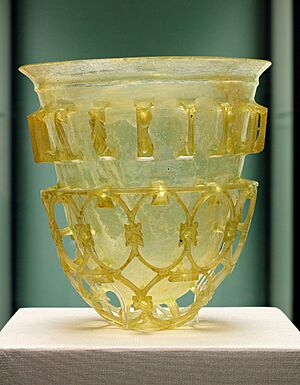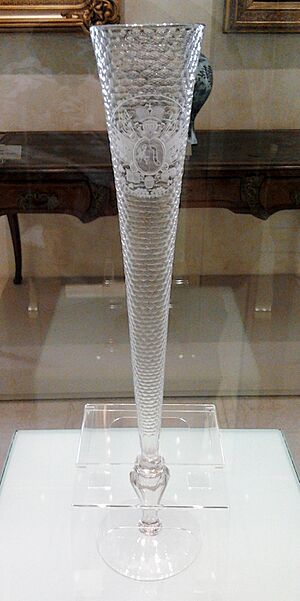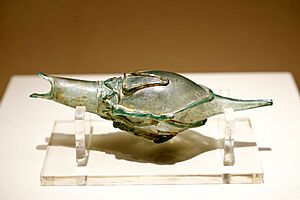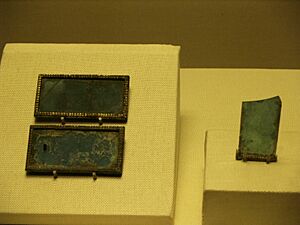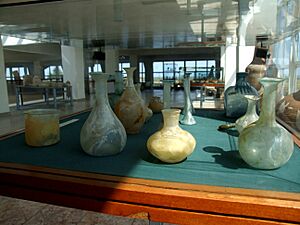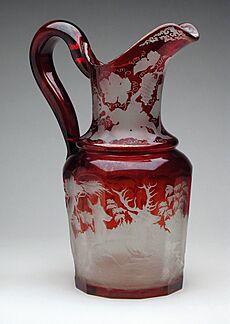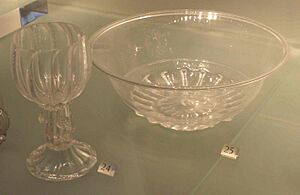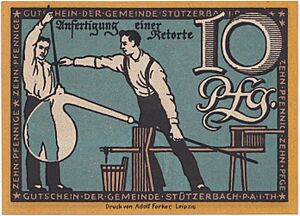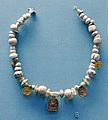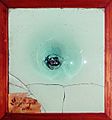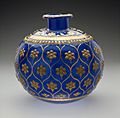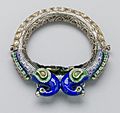History of glass facts for kids
The history of glass-making is super old! People started making glass at least 3,600 years ago. This happened in places like Mesopotamia, Syria, or ancient Egypt. The first glass objects were small beads, made around 2,000 BCE. These might have been accidental leftovers from metal-working or from making a material called faience. For a long time, glass was a luxury item. But then, big problems hit the Bronze Age civilizations, and glass-making almost stopped.
Glass technology in India might have started around 1,730 BCE. Later, across the old Roman Empire, archaeologists found glass items. These were used in homes, factories, and even for funerals. In Anglo-Saxon England, glass was used for cups, beads, windows, and even in jewelry.
How Glass Began
Naturally found glass, like volcanic obsidian, was used by early humans. They made sharp tools from it. But the first real glass was likely made in coastal north Syria, Mesopotamia, or ancient Egypt. Egypt has a good environment for things to last, so many early glass pieces are found there. The very first glass objects were beads. They might have been made by accident while working with metal or making faience. Faience was a shiny material similar to glass.
During the Late Bronze Age in Egypt and Western Asia, glass-making grew fast. People found colored glass blocks and fancy cups. These cups often looked like valuable gemstones. The glass was made using soda ash, which comes from plant ashes. Early glass cups were made by wrapping soft glass around a clay and sand core.
Then, thin threads of different colored glass were added. These threads were swirled to make cool patterns. The cup was then rolled smooth to press the decorations in. Handles and feet were added separately. After cooling, the core was scraped out. Glass shapes for inlays were also made in moulds. Much of the early glass was shaped by grinding it when it was cold.
By 1500 BCE, a lot of glass was being made in Western Asia, Crete, and Egypt. It's thought that the secrets of making glass were kept by powerful states. So, glass workers in other places had to buy ready-made glass. This often came in blocks, like those found on the Ulu Burun shipwreck.
Glass stayed a luxury item. When the Bronze Age civilizations fell, glass-making stopped for a while. It started up again in Syria and Cyprus around the 9th century BCE. This is when people learned how to make clear glass.
The first "how-to" guide for making glass is from about 650 BCE. It was found on clay tablets in the library of the Assyrian king Ashurbanipal. In Egypt, glass-making came back when the Ptolemaic rulers took over. New ways of making glass were discovered.
During the Hellenistic period, many new glass-making methods appeared. Glass started to be used for bigger items, like table dishes. Techniques like 'slumping' (melting glass over a mould) and 'millefiori' (making patterns like "thousand flowers" from sliced glass rods) were developed. People also started to really value clear glass.
An old story says that Phoenician traders discovered glass by accident. They were cooking on a beach and used blocks of a substance called nitrum to prop up their pots. The nitrum melted with the sand and made a new clear liquid. This story shows how Romans thought glass was made. Around 100 BCE, glass blowing was invented. This changed the glass industry completely! Glass cups became much cheaper than pottery. Glass became very common throughout the Roman world. With clear glass (thanks to manganese dioxide), Romans started using glass for windows. Glass windows, even if they weren't perfectly clear, appeared in important buildings. Over the next 1,000 years, glass-making spread through Europe and beyond.
Glass Around the World
Glass in Iran
The first glass in Iran was found as beads from the late Bronze Age (1600 BCE). Glass tubes were also found from the middle Elamite period. Fancy mosaic glass cups were discovered in northern Iran. These cups looked like ones from Mesopotamia.
Glass tubes for kohl (an eye cosmetic) were found from the Achaemenid period. During this time, glass cups were usually plain and clear. Later, Greek and Roman glass-making styles became popular. In the Sasanian period, glass items were decorated with local designs.
Glass in India
The earliest glass in India is a brown glass bead from Harappa, dating to 1700 BCE. This is the oldest glass found in South Asia. Later glass from 600 to 300 BCE shows common colors.
Old Indian texts mention glass, suggesting it was known around 1000 BCE. Glass items were also found at sites dating to about 500 BCE. But the first clear signs of widespread glass use come from Taxila (3rd century BCE). Many glass bracelets, beads, and small cups were found there. These glass-making skills might have come from Western Asia.
The site of Kopia in Uttar Pradesh was the first place in India to make glass locally. Early Indian glass was different from glass from Babylon, Rome, and China. By 1 AD, glass was used for decorations in South Asia. Contact with the Greco-Roman world brought new techniques. Indian artists became very good at shaping, decorating, and coloring glass.
Glass in China
In China, glass was not as important as pottery or metalwork. The earliest glass items in China are from the Warring States period (475–221 BCE). They are rare and found in limited places.
Glass-making started later in China than in Mesopotamia, Egypt, and India. Imported glass objects first arrived in China around the early 5th century BCE. These were colorful "eye beads." These imports encouraged China to start making its own glass beads.
During the Han Dynasty (206 BCE–220 CE), glass was used for more things. People started casting glass, making items like bi disks and other ritual objects. Chinese glass from this time was chemically different from imported glass. It had high levels of barium oxide and lead. The lead-barium glass style ended around 220 AD. Glass production started again in the 4th and 5th centuries AD.
Glass in the Roman Empire
Roman glass production grew from Hellenistic techniques. At first, they focused on making brightly colored, cast glass cups. Glass items have been found all over the Roman Empire. They were used in homes, for funerals, and in workshops. Glass was mainly used for cups, but also for mosaic tiles and window glass.
However, in the 1st century AD, glass-making changed quickly. Glass blowing was introduced, and clear glass became very popular. Raw glass was made in some places, and then sent to other places to be shaped into finished items. By the end of the 1st century CE, large factories, especially in Alexandria, made glass a common material for everyone in the Roman world.
Glass in the Islamic World
Islamic glass continued the great work of earlier cultures, especially Sasanian glass from Persia. An Arab poet from the 800s described how clear this glass was. In the 8th century, a Persian-Arab chemist named Jābir ibn Hayyān wrote 46 recipes for making colored glass. By the 11th century, clear glass mirrors were being made in Islamic Spain.
Glass in Africa
Glass and glass beads were also made in the kingdom of Benin during later times.
Glass in Medieval Europe
After the Western Roman Empire fell, new ways of making glass appeared in Northern Europe. Artisans made "forest glass" from local materials. Byzantine Glass continued the Roman style in the Eastern Empire. The "claw beaker" was a popular cup that showed off glass's unique qualities.
Glass items from the 600s and 700s were found near Venice. These show a link between Roman times and Venice's later importance in glass-making. Around 1000 AD, a big step forward happened in Northern Europe. Glass made from white pebbles and burnt plants was replaced by glass made from potash (wood ashes). From then on, northern glass was very different from Mediterranean glass.
Until the 1100s, stained glass (glass colored with metals) was not widely used. But it quickly became very important for Romanesque art and Gothic art, especially in churches. In the 11th century, Germany found new ways to make flat glass by blowing large spheres. These spheres were swung to form cylinders, then cut and flattened. This method was perfected in 13th century Venice. The crown glass process was used until the mid-1800s. In this method, a glassblower would spin hot glass until it flattened into a large disk. This disk was then cut into window panes. Everyday glass cups in late medieval Northern Europe are called forest glass.
Anglo-Saxon Glass
Anglo-Saxon glass has been found all over England. Glass was used for cups, beads, windows, and jewelry. After the Romans left Britain in the 5th century AD, much less glass was found.
Most complete glass cups and bead collections come from early Anglo-Saxon burial sites. But when Anglo-Saxons became Christian in the late 600s, they were buried with fewer items, so glass is rarely found. From the late 600s onwards, window glass is found more often. This is because of the new churches and monasteries being built. Some Anglo-Saxon writings mention glass, mostly window glass in churches. Anglo-Saxons also used glass in their jewelry.
Murano Glass
Murano island in Italy became the main place for fancy Italian glass-making from the 1300s. They invented many new techniques and sold a lot of glass all over the world. What made Murano glass special was that the local sand was very pure. It was mixed with soda ash from the Middle East, which Venice had a special right to get. The clearest glass was colored in two ways: by adding natural coloring agents to the melted glass, or by making a black glass that showed its true color when held to light.
Venice's ability to make this great glass gave them a trade advantage. Murano became famous for glass-making when the Venetian Republic ordered glassmakers to move their workshops there in 1291. This was because they worried about fires in the city's wooden buildings. Murano's glassmakers became very important citizens. They were not allowed to leave the Republic. But many took the risk and set up glass factories in other cities, even in England and the Netherlands.
Bohemian Glass
Bohemian glass, also called Bohemia crystal, is decorative glass made in parts of the Czech Republic since the 1200s. The oldest glass-making sites are from around 1250. Important glass-making towns include Skalice, Kamenický Šenov, and Nový Bor. Both Nový Bor and Kamenický Šenov have Glass Museums with many items from the 1600s onwards. Bohemian glass was especially amazing in the Baroque style from 1685 to 1750. In the 1600s, Caspar Lehmann, a gem cutter, learned to engrave glass using metal wheels.
Modern Glass Production
New Ways to Make Glass
A very important step in glass making was adding lead oxide to the melted glass. This made the glass look better and easier to melt. It also made the glass easier to shape for longer. George Ravenscroft first discovered this in 1674. He was the first to make clear lead crystal glass on a large scale. Ravenscroft had the money and knowledge to change the glass trade. England then became the main place for glass, taking over from Venice. His first glass sometimes developed small cracks. He fixed this by adding lead oxide.
He got a special patent, and his work moved to a quieter place. By 1696, after his patent ended, many glass factories in England were making this "flint glass." They sold it all over Europe. It was so successful that in 1746, the British Government put a tax on it. Instead of using less lead, makers created smaller, more delicate glass items. The British glass industry really grew after the tax was removed in 1845.
The method of making "blown plate glass" for mirrors and coach windows started around 1620 in London. In 1688, Louis Lucas de Nehou and A. Thevart in France perfected casting polished plate glass. Before this, mirrors made from blown glass were small. De Nehou's method of rolling melted glass on an iron table made very large plates possible. This method was adopted in England in 1773. The polishing process became industrial around 1800, using steam engines.
Making Glass in Factories

The use of glass in buildings became popular after The Crystal Palace was built in 1851. This building, designed by Joseph Paxton, used glass as its main material. It inspired people to use glass in homes and gardens. In 1832, the British Crown Glass Company started using the cylinder method to make sheet glass. This glass was made by blowing long glass cylinders, then cutting them open and flattening them. "Plate glass" involved pouring glass onto an iron bed and rolling it into a sheet. The soft sheet was then moved into a special oven to cool slowly. James Hartley introduced the "Rolled Plate" method in 1847. This made ribbed glass, often used for large glass roofs like in railway stations.
An early step in making glass automatically was patented in 1848 by Henry Bessemer. His system made a continuous ribbon of flat glass between rollers. This was expensive and later stopped. Bessemer also tried an early form of "Float Glass" in 1843. This involved pouring glass onto liquid tin.
In 1887, mass production of glass began in England. Machines could make 200 standard bottles per hour, much faster than old methods. Patterned glass was also made by machine from 1888.
In 1898, Pilkington invented Wired Cast glass. This glass has a strong steel-wire mesh inside for safety. The "machine drawn cylinder technique" was invented in the US. It was the first mechanical way to make window glass. Pilkington made it under license in the UK from 1910.
In 1938, the polished plate process was improved by Pilkington. Between 1953 and 1957, Sir Alastair Pilkington and Kenneth Bickerstaff developed the amazing float glass process. This was the first successful way to make a continuous ribbon of glass. It flows on a bath of molten tin and becomes perfectly flat and even in thickness. Most modern windows are made from float glass. The success of this process came from carefully controlling how much glass was fed onto the tin bath. Float glass sales became very profitable in 1960.
Images for kids
-
Mouth-blown window-glass from Sweden (1742) with a mark from the glassblower's pipe.
-
A Siphon bottle for seltzer water, from 1922.
-
A perfume set from the Soviet Union, around 1965.
See also
- Early glassmaking in the United States
- 18th century glassmaking in the United States


